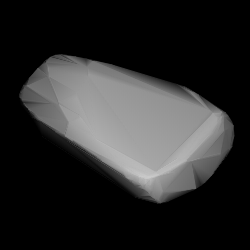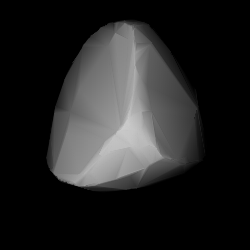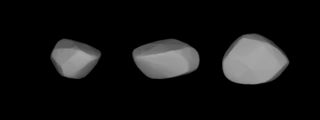
1130 Skuld, provisional designation 1929 RC, is a stony Florian asteroid from the inner regions of the asteroid belt, approximately 10 kilometers in diameter. It was named after Skuld from Norse mythology.

1799 Koussevitzky is an asteroid of the Eos family from the outer regions of the asteroid belt, approximately 18 kilometers in diameter. It was discovered on 25 July 1950, by astronomers at Indiana University during the Indiana Asteroid Program at Goethe Link Observatory in Indiana, United States. The K-type asteroid has a rotation period of 6.3 hours. It was named for Russian conductor Serge Koussevitzky.

1069 Planckia, provisional designation 1927 BC, is a background asteroid from the outer regions of the asteroid belt, approximately 39 kilometers in diameter. It was discovered on 28 January 1927, by astronomer Max Wolf at the Heidelberg-Königstuhl State Observatory in Germany. The asteroid was named after German physicist Max Planck.
1043 Beate, provisional designation 1925 HB, is a stony asteroid from the outer region of the asteroid belt, approximately 32 kilometers in diameter. It was discovered by German astronomer Karl Reinmuth at the Heidelberg-Königstuhl State Observatory on 22 April 1925. Any reference of its name to a person is unknown.

1056 Azalea, provisional designation 1924 QD, is a stony Florian asteroid from the inner regions of the asteroid belt, approximately 12 kilometers in diameter. It was discovered on 31 January 1924, by astronomer Karl Reinmuth at the Heidelberg-Königstuhl State Observatory in southwest Germany. The asteroid is named after the Azalea flower.
1064 Aethusa, provisional designation 1926 PA, is a stony background asteroid from the central regions of the asteroid belt, approximately 19 kilometers in diameter. It was discovered on 2 August 1926, by astronomer Karl Reinmuth at the Heidelberg-Königstuhl State Observatory in southwest Germany. The asteroid was named after the plant Aethusa cynapium.
1112 Polonia, provisional designation 1928 PE, is an Eoan asteroid from the outer regions of the asteroid belt, approximately 38 kilometers in diameter. Discovered by Soviet astronomer Pelageya Shajn at Simeiz in 1928, it was the first asteroid discovery made by a woman. The L-type asteroid has a long rotation period of 82.5 hours, and was named for the country of Poland.

1133 Lugduna, provisional designation 1929 RC1, is a stony Florian asteroid from the inner regions of the asteroid belt, approximately 9.5 kilometers in diameter. It was discovered on 13 September 1929, by Dutch astronomer Hendrik van Gent at the Leiden Southern Station annex to the Union Observatory in Johannesburg, South Africa. The asteroid was named in honor of the city of Leiden in the Netherlands.

1140 Crimea, provisional designation 1929 YC, is a stony asteroid from the middle region of the asteroid belt, approximately 28 kilometers in diameter. It was discovered on 30 December 1929, by Soviet astronomer Grigory Neujmin at Simeiz Observatory on the Crimean peninsula, after which it was named.
3037 Alku, provisional designation 1944 BA, is a carbonaceous asteroid from the central region of the asteroid belt, approximately 20 kilometers in diameter. It was discovered on 17 January 1944, by Finnish astronomer Yrjö Väisälä at Turku Observatory in Southwest Finland.

1328 Devota, provisional designation 1925 UA, is a dark background asteroid from the outermost regions of the asteroid belt, approximately 56 kilometers in diameter. It was discovered on 21 October 1925, by Russian–French astronomer Benjamin Jekhowsky at the Algiers Observatory in North Africa. The asteroid was named after Argentine astronomer Fortunato Devoto.

1805 Dirikis, provisional designation 1970 GD, is a stony Themistian asteroid from the outer region of the asteroid belt, approximately 26 kilometers in diameter.

1241 Dysona, provisional designation 1932 EB1, is a dark background asteroid from the outer regions of the asteroid belt, approximately 77 kilometers in diameter. It was discovered on 4 March 1932, by English astronomer Harry Edwin Wood at the Union Observatory in Johannesburg, South Africa. The asteroid was named after English astronomer Frank Watson Dyson.
3915 Fukushima, provisional designation 1988 PA1, is a carbonaceous asteroid from the inner regions of the asteroid belt, approximately 21 kilometers in diameter.

1188 Gothlandia, provisional designation 1930 SB, is a stony Florian asteroid from the inner regions of the asteroid belt, approximately 12 kilometers in diameter. Discovered by astronomer Josep Comas i Solà at the Fabra Observatory in 1930, the asteroid was later named after the ancient name of the Spanish autonomous community of Catalonia.
6255 Kuma, provisional designation 1994 XT, is a carbonaceous asteroid from the central region of the asteroid belt, approximately 22 kilometers in diameter. It was discovered on 5 December 1994, by Japanese astronomer Akimasa Nakamura at Kuma Kogen Astronomical Observatory on the Island of Shikoku, Japan. It was named after the Japanese town of Kumakōgen.

1249 Rutherfordia, provisional designation 1932 VB, is an elongated, stony Florian asteroid from the inner regions of the asteroid belt, approximately 13 kilometers in diameter. Discovered by Karl Reinmuth at Heidelberg Observatory in 1932, the asteroid was named after Rutherford, New Jersey a suburb of New York City, United States.
1255 Schilowa, provisional designation 1932 NC, is a background asteroid from the outer regions of the asteroid belt, approximately 34 kilometers in diameter. It was discovered on 8 July 1932, by Soviet astronomer Grigory Neujmin at the Simeiz Observatory on the Crimean peninsula. The asteroid has a longer-than average rotation period of 29.5 hours. It was named after Mariya Zhilova (Schilowa), who was Russia's first professional female astronomer.
1266 Tone is a dark background asteroid from the outer regions of the asteroid belt, approximately 80 kilometers in diameter. Discovered by astronomer Okuro Oikawa at the Tokyo Observatory in 1927, it was assigned the provisional designation 1927 BD. The asteroid was later named after the Tone River, one of Japan's largest rivers.

1590 Tsiolkovskaja, provisional designation 1933 NA, is a stony Flora asteroid from the inner regions of the asteroid belt, approximately 11 kilometers in diameter. It was discovered on 1 July 1933, by Soviet–Russian astronomer Grigory Neujmin at Simeiz Observatory, on the Crimean peninsula. It was named for rocket scientist Konstantin Tsiolkovsky.












